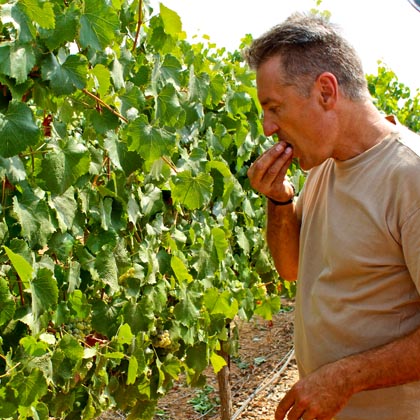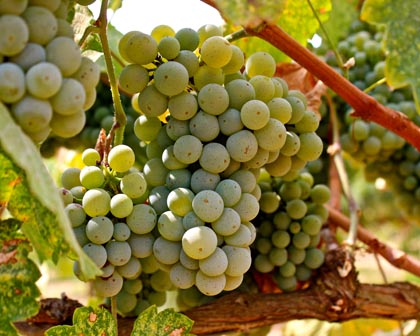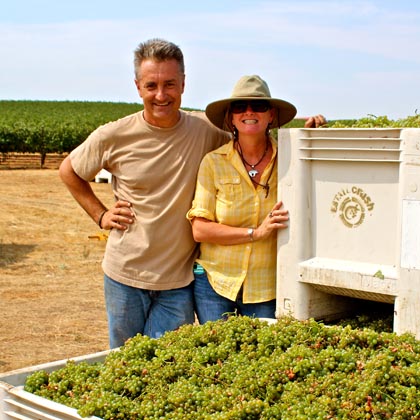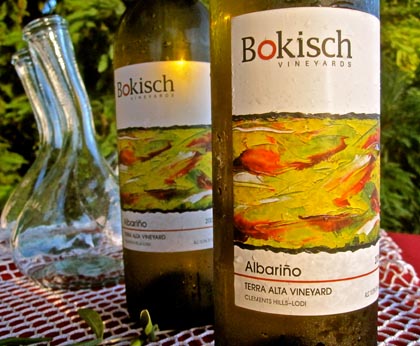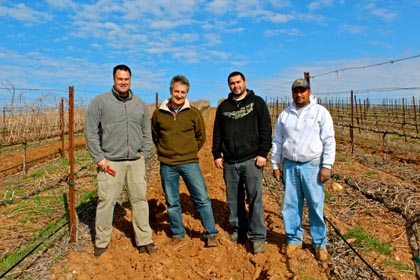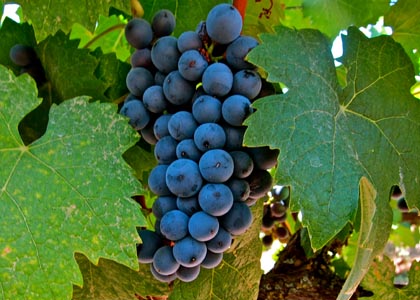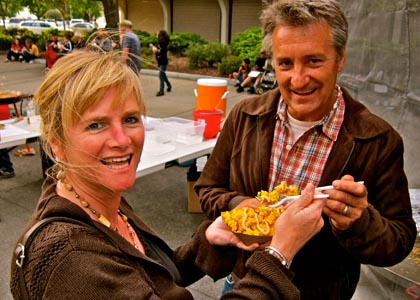Letters from Lodi
An insightful and objective look at viticulture and winemaking from the Lodi
Appellation and the growers and vintners behind these crafts. Told from the
perspective of multi-award winning wine journalist, Randy Caparoso.
Markus Bokisch looks back at 2012
Markus Bokisch tastes 2012 Verdelho harvest in his Vista Luna Vineyard
Here at the end of 2012, it makes sense to catch up with Markus Bokisch, whose Bokisch Ranches have become one of the most important vineyard management companies in the Lodi American Viticultural Area (a.k.a. AVA).
Bokisch Ranches is not the largest grower in Lodi – that would be companies like LangeTwins Family, John Kautz Farms, Vino Farms, the Dosio family’s Pacific Agri Lands, and a few others – but they are significant because of their upward growth despite increasing economic barriers (2,200 bearing acres of wine grapes, with another 900 acres in development), and because they sell to such a large number of specialty wineries throughout the state, who also tend to garner the most press.
Vista Luna Vineyard Verdelho
Says Mr. Bokisch, “of the approximately 50 buyers of our grapes, 7 are large production wineries, 7 are in the mid-range, 30 are what you would call ‘boutique,’ and 6 are ‘mad-scientist’ home winemakers.” The boutiques include prestigious producers like Napa Valley’s Turley, Neyers and Kongsgaard; but some of the other small commercial wineries on Bokisch’s client list, like The Scholium Project, Forlorn Hope and Odisea/Cochon, could also be considered “mad scientist-y.”
As is often the case, it’s the tiner, unrestrained, sometimes wackier wineries that often make the most waves: producers who are apt to adopt natural or native yeast fermentation as standard procedure (whereas, in over 99% of wineries, fermentations inoculated by laboratory cultured yeasts are the norm); even going so far as fermenting white wines on their skins, as if they were red wines. The results may be unpredictable, but rarely uninteresting — especially to the media and geekier elements of the wine trade and consumers.
The reason Bokisch Ranches attracts such a diverse winery clientele, of course, is because they grow interesting grapes. Among the nine varieties of white wine grapes grown by Bokisch: Chardonnay, Pinot Gris, Riesling, and Verdelho; as well as the less mainstream Albariño, Garnacha Blanca, Verdejo, Verdelho and Orange Muscat.
Among the black skinned grapes in the Bokisch portfolio: Merlot, Cabernet Sauvignon, Zinfandel, Syrah, Malbec, Pinot Noir, Barbera and Petite Sirah; along with the lesser known Petit Verdot, Dornfelder, Monastrell (a.k.a. Mourvèdre), Graciano, Garnacha Tinta (a Spanish variant of Grenache), and Tempranillo.
Mr Bokisch (and his wife, Liz), of course, are also one of California’s pioneers of Spanish inspired varietal wines, produced and bottled under their own Bokisch Vineyards label; and with over 15 vintages under their belt, they are undisputedly among the best.
Markus & Liz Bokisch
Last week Mr. Bokisch took a break to talk about the state of Bokisch Vineyards & Ranches.
What are the major vineyards you are now farming , and in which sub-AVAs or they are they in?
“In the Borden Ranch AVA, we have Vista Luna, Vista Del Sol, Borden Hills, Clay Station, Luna Nueva, Vista Del Rio, and Wild Hare. In the Sloughhouse AVA, there is Sheldon Hills. In Clements Hills AVA, there is Terra Alta, Belle Colline, Hunter’s Oak, Paddy Creek, Old Oak, Clements Oaks, William-Marie, Fisher, and Emde.
“In the Jahant AVA, we have Liberty Oaks Vineyard. The Linden Ridge Vineyard falls in the broader Lodi AVA; and in the historic Mokelumne River AVA, there is Las Cerezas, Kramer, and River Vine, Kirschenmann, and next door to Kirschenmann, Ross Schmiedt’s Dairy Vineyard. Incidentally, we also farm vineyards in Solano, Sacramento and Amador counties.
"This past spring you also started farming the old Kirschenmann Vineyard for Tegan Passalacqua, the vineyard manager of Turley Wine Cellars. What viticultural changes are you and Tegan starting to implement in this heritage planting, planted mostly to 98 year old Zinfandel vines?
“This is perhaps the most exciting task I have been challenged with recently. It is one thing to begin vineyard from scratch, which is like painting a picture which is sensitive to the chosen site – a picture designed to endure the test of time. It is quite another thing to farm an old vineyard that was ‘born’ before World War I.
“In this situation my role changes from being a strict taskmaster, attempting to extract quality from young vines, to that of a careful and patient steward, who follows in the footsteps of those who came before him. My goal is to leave the vineyard in a better state of health by the time my tenure is done, and a younger generation takes my place.
“To that end, Tegan and I are excited about converting the vines back to organic farming;, which is how it’s been farmed most of its 98 years, since its inception till sometime after WWII with the coming of the ‘chemical revolution’ in agriculture. Short term goals involve rigorous crown suckering, thinning secondary shoots, leaf pulling around the clusters, and minimal irrigation.
“Longer term goals include a focus on redeveloping shoot positions on many of the vines whose arms have been weakened or broken over the years. Also, replanting missing vines, and cataloging the various non-Zinfandel vines (i.e. Carignan and Mondeuse Noire) that pepper the old vine block.”
As the years go by, what have you noticed in the various terroirs of, say, Jahant, Clements Hills and Mokelumne River that are making the most differences in the wines (especially under the Bokisch label)?
“Painting broad brush strokes, I would say that the older, higher clay content, volcanic soils (in Jahant, Borden Ranch and Clements Hills) tend to create greater tannic structure in the wines. They tend to take longer to open up, and even go through more awkward moments in the cellar in their barrel life. However, patience rewards you with deeper, chewier wines.
“The younger soils (i.e. Tokay Sandy Loam) of the Mokelumne AVA tend to heighten floral and fruit aromatics, while having more approachable, softer tannins in youth. We find that blending wines from these different soils leads to greater complexity. Jahant tends to have higher levels of clay with no cobble. This soil does exceptionally well with Tempranillo. This variety ripens quickly, with better than average acids and great structure on these old alluvial banks.”
Turley's Tegan Passalacqua (left) with the Bokisch crew in Liberty Oaks Vineyard
Are you noticing a growing interest in Spanish varietals, and has it prompted you to increase production of your Bokisch label wines?
“We have certainly seen robust interest in Spanish varietals both in our vineyards and wines. We now have approximately 140 acres of Iberian varieties planted in four AVA’s. Our two newest developments will increase this number by at least another 40 acres.
“We have slowly increased production of our wines over the years; however, at a slower pace than our vineyards, because the vineyard developments have taken much of our spare time. We keep selling out earlier every year, so we have decided to take a larger growth leap in 2013. We are currently at 2,200 cases.
”In the past, you’ve done separate bottlings of Mokelumne River and Clements Hills Albariño, and you’ve spoke of possibly going back to that. Are the differences distinctive or interesting enough to warrant that?
“The difference in the terroirs of these two AVAs is enormous, and this stark difference translates into the character of the resulting wines. The richer, deeper Mokelumne River soils create notes of apricot and litchi nut. The more weathered, Clements Hills red dirt develops into wines of intense minerality and notes of tangerine. We keep the two vineyard fermentations separate every year. In most years we bottle them separately. I see us adding to this program in the future with the addition of other Albariño vineyards.
La Cerezas Vineyard Graciano
“We now have four Albariño sites in four different AVAs. Las Cerezas, our mother block, is in Mokelumne River. Terra Alta is in Clements Hills. Vista Luna is on the Borden Ranch. Finally, Gomes-Andrus is on Andrus Island in the California Delta.”
Could you summarize the 2012 harvest – in general terms, in particular for your Spanish grapes, and for Clements Hills and Jahant? Did you experience anything slightly different from other growers?
“The 2012 vintage was overall a very good year. This was because we had very few temperature extremes throughout the entire season. Fruit ripened evenly and over a relatively long season, developing intensity and complexity in aromatics in particular. The season tended to tease out the varietal characteristics in a more defined fashion than in most years. Albariño was extremely ‘Albariño,’ Verdelho was ‘Verdelho,’ etc.
“An added benefit to the year, unlike the past two, was that most later reds ripened fully with little to no threat of rain. I cannot recall a season with less evidence of even the slightest rot in susceptible varieties such as Petite Sirah and Zinfandel. It was a heavy crop year, which is surprising after such a dry winter. This meant that there were more than a few vineyard blocks throughout the district that were not properly thinned early, and thus lost potential concentration.
“In regards to Iberian varietals, the 2012 Grenache and Monastrell had universally fabulous concentration of color; Tempranillo held on to its acids better than normal, and Graciano showed itself in one of its more brilliant permutations. The whites, across the board, were phenomenal. Perhaps the one that stood out of the crowd by heads and shoulders was the Garnacha Blanca. It was overflowing with flavors and aromatics that wafted in the morning air during its harvest.”
Well, then – we can hardly wait to taste the first of the 2012s next spring!
Liz & Markus Bokisch enjoying Addy's Paella in Downtown Lodi
